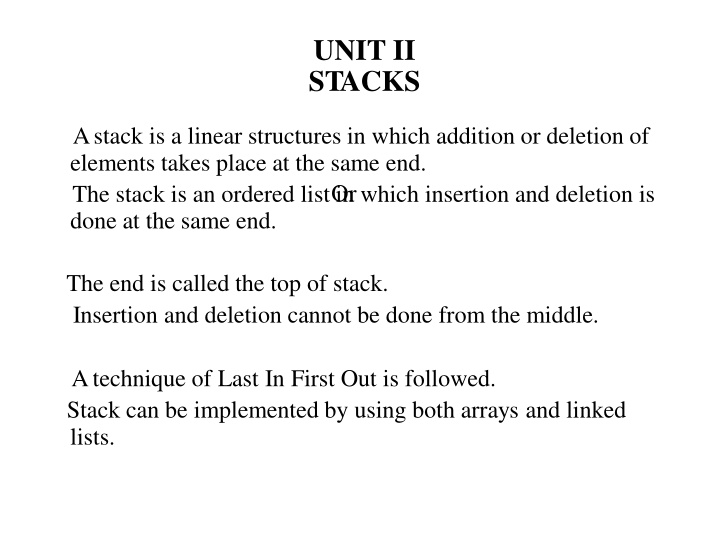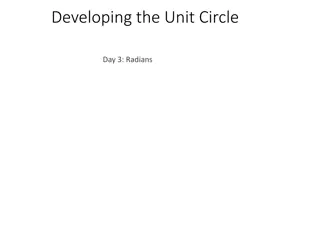
Introduction to Stacks: Definitions, Operations, and Implementations
Learn about stacks, a fundamental data structure involving Last In First Out (LIFO) order. Understand stack operations, abstract data types, and implementations using arrays and linked lists. Discover advantages and disadvantages of stack implementations in C programming.
Download Presentation

Please find below an Image/Link to download the presentation.
The content on the website is provided AS IS for your information and personal use only. It may not be sold, licensed, or shared on other websites without obtaining consent from the author. If you encounter any issues during the download, it is possible that the publisher has removed the file from their server.
You are allowed to download the files provided on this website for personal or commercial use, subject to the condition that they are used lawfully. All files are the property of their respective owners.
The content on the website is provided AS IS for your information and personal use only. It may not be sold, licensed, or shared on other websites without obtaining consent from the author.
E N D
Presentation Transcript
UNIT II STACKS Astack is a linear structures in which addition or deletion of elements takes place at the same end. Or The stack is an ordered list in which insertion done at the same end. and deletion is The end is called the top of stack. Insertion and deletion cannot be done from the middle. Atechnique of Last In First Out is followed. Stack can be implemented by using both arrays and linked lists.
STACKADT Stacks can also be defined asAbstract Data Types(ADT). Astack of elements of any particular type is a finite sequence of elements of that type together with specific operations. Therefore, stacks are called LIFO lists.
STACK OPERATIONS The primitive operations on stack are To To To To To create a stack. insert an element on to the stack. delete an element from the stack. check which element is at the top of the stack. check whether a stack is empty or not.
STACK OPERATIONS If Stack is not full , then add a new node at one end this operation is called PUSH. of the stack If the stack is not empty then delete the node at its top. This operation is called POP . PUSH and POPare functions of operations. TOPis the pointer locating the stack current position. stack used to fulfill the stack
ARRAYIMPLEMENTATIONIN C Stacks can be represented in the memory arrays by maintaining a linear array STACK and a pointer variable which contains the location of top element. TOP The Variable MAXSTACK gives maximum number of elements held by the stack. The TOP=NULL /0 will indicate that the stack is empty. The operation of adding and removing an item in the stack can be implemented using the PUSH and POPfunctions.
DISADV ANTAGE OFSTACK USINGARRAYS The array representation of stack suffers from the drawbacks of the array s size, that cannot be increased or decreased once it is declared . The space is wasted, if not used , or, there is shortage of space if needed.
LINKED IMPLEMENTATIONIN C The stack can be implemented using linked lists. The stack as linked list is represented as a single linked list. Each node in the list contains data and a pointer to the next node.
APPLICATION OF STACKS Reversing a list. Conversion of Infix to Postfix Expression. Evaluation of Postfix Expression. Conversion of Infix to Prefix Expression. Evaluation of Prefix Expression.
CONVERSION OFINFIX TO POSTFIX EXPRESSION While evaluating an infix expression, operations are executed according to the order as follows: Brackets / Parentheses. Exponentiation. Multiplication / Division. Addition / Subtraction. the operators with the same priority(e.g. * and /) are evaluated from left to right.
STEPS TO CONVERT INFIX TO POSTFIX EXPRESSION Step 1: braces. The actual evaluation is determined by inserting Step 2: Convert the expression in the innermost braces into postfix notation by putting the operator after the operands. Step 3: Repeat the above step (2) until the entire expression is converted into postfix notation.
EXAMPLE OFINFIXTO POSTFIX CONVERSION
RECURSIONIMPLEMENTATION If a procedure contains either a call statement to itself/to a second procedure that may eventually result in a cell statement back to the original procedure. Then such a procedure is called as recursive procedure. Recursion may be useful in developing algorithms for specific problems. The stack may be used to implement recursive procedures.
QUEUE Queue is a linear list of element can take called the front and insertion can called the rear. The first element from the list. elements in which deletion of an place only at one end, take place only at the other end, in a queue will be the first one to be removed Therefore, queues are called FIFO lists.
QUEUEADT The definition of an abstract data type clearly states that for a data structure to be abstract, it should have the two characteristics as follows. There should be a particular way in related to each other. which components are A statement of the operations that can be performed on element of the abstract data type should specified.
QUEUE OPERATIONS Queue overflow. Insertion of the element into the queue. Queue underflow. Deletion of the element from the queue. Display of the queue.
ARRAYIMPLEMENTATIONIN C Array is a data structure that stores a fixed number of elements. One of the major limitations be fixed prior to using it. of an array is that its size should The size of the queue keeps on changing as the elements are either removed from the front end or added at the rear end. The solution of this problem is to declare maximum size. an array with a
INSERTIONAND DELETION OPERATIONSIN QUEUE USINGARRAYS We consider two variables front and rear which are declared to point to both the ends of the queue. The array begins with index therefore , the maximum number of elements that can be stored can be consider as MAX-1(n-1). If the number of elements are already stored in the queue is reported to be full. If the elements are added then the rear is incremented using the pointer and new item is stored in the array.
ADDING ELEMENTS INAQUEUE The front and rear variables are initially set to -1, which denotes that the queue is empty. If the item being added is the first element then as the item is added, .the queue front is set to 0 indicating that the queue is now full.
DELETINGELEMENTS INAQUEUE For deleting elements from the queue, the function first checks if there are any elements for deletion. If not , the queue to be empty otherwise an element is deleted. is said
LINKED IMPLEMENTATIONIN C The linked list representation of a queue does not have restrictions on the number of elements it can hold. any The elements are allocated dynamically , hence it can grow as long as there is sufficient memory available for dynamic allocation.
APPLICATION OF QUEUE Job scheduling. Categorizing data. Random number generation.
TYPES OF QUEUES Circular queue. De queue (double ended queue). Priority queue.
CIRCULAR QUEUE Circular queues are implemented in a straight line. in circular form rather than This form over come the problem queue implemented as an array. of unutilized space in linear In the array implementation there is a possibility that the queue is reported full even though slots of the queue are empty.
CIRCULAR QUEUE Suppose an array x of n elements is used to implement a circular queue. If we go on adding elements may reach x[n-1]. to the queue we In a queue array if the elements reach the end then it reports the queue is full even some slots are empty but in circular queue ,it would not report as full until all the slots are occupied.
REPRESENTATIONOFCIRCULAR QUEUE
ADDING ELEMENTS INTO CIRCULAR QUEUE The conditions that are checked before inserting the elements : If the front and rear are in adjacent locations(i.e. rare following front)the message Queue is full is displayed. If the value of front is -1 then it denotes that the queue is empty and that the element to be added would be the first element in the queue . The value of front and rear in such a case are set to 0 and new element gets placed at position. 0Th
ADDING ELEMENTSINTO CIRCULAR QUEUE Some of the positions at the front end of the array might be empty . This happens if we have deleted some elements from the queue , when the value of rear is MAX-1 and the value of front is greater than 0. In such a case value of rear is set to 0 and the element to be added is added to this position. The element is added at the rear position in case the value of front is either equal to or greater than 0 and the value of rear is less than MAX-1.
DELETING ELEMENTS INTO CIRCULAR QUEUE The conditions that are checked before deleting the elements : First it is checked whether the queue is empty or not . The elements at the front position will be deleted. Now , it is checked if the value of front is equal to rear . If it is, then the element which will be deleted is the only element in the queue . If the element is removes, the queue and rear are set to -1. will be empty and front
DELETING ELEMENTS IN CIRCULAR QUEUE On Deleting an element from the queue the value of front is set to 0 if it is equal to MAX-1 otherwise front is simply incremented by 1.
DOUBLE ENDED QUEUE Adeque is a linear list in which elements can be added or removed at either end but not in the middle. There are two variations of a deque an input restricted deque and an output restricted deque which are intermediate between deque and a regular queue. An input restricted deque is a deque which allows insertions at only one end of the list , but allows deletions at both ends of the list
DOUBLE ENDED QUEUE The output restricted deque is a deque which allows deletions at only one end of the list but allows insertions at both ends of the list. The two possibilities that must consider while inserting /deleting elements into the queue are: When which an attempt is made to insert an element into a deque is already full, an overflow occurs. When which an attempt is made to delete an element from a deque is empty, underflow occurs.






















